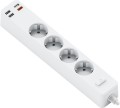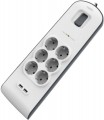Cable length
The length of the cable used to connect the surge protector to the network.
The longer the cable, the farther from the outlet you can install the device. On the other hand, a long cable can be inconvenient over short distances. Models on a coil are deprived of this drawback (see "Type"), this moment is compensated by the actual presence of the coil, but they differ in large dimensions and heavy weight. So when choosing, it is far from always worth chasing the maximum length of the wire.
Max. power
The highest power consumption of the connected devices that the surge protector can tolerate without consequences (to be more precise, with which it can work indefinitely without overloads, overheating, etc.).
This limitation is due to the fact that the higher the power at the same voltage, the higher the current passing through the equipment (in this case, through the surge protector); and off-design currents can lead to breakdowns and even accidents. And although in order to avoid these consequences, modern filters often provide various types of protection (see above), however, the operation of protection is still an emergency situation that is best avoided. Therefore, it is worth choosing a model according to this parameter in such a way that the maximum filter power is at least not lower than the total power consumption of the load. And it is best to have a margin of 20 – 30% — this will give additional guarantees in case of various deviations in the operation of the connected equipment.
Separately, it is worth highlighting the situations when the filter is planned to be used for the so-called reactive load — electrical appliances that widely use circuits on capacitors and/or inductors, for example, power tools or refrigeration units. The total power consumption of such devices (written in volt-amperes) can be much higher than the active power (which is indicated in watts). The recommended line filter power in such cases is calculated using special...formulas that can be found in the relevant sources.
Max. load
The maximum current that the surge protector can pass through itself for an unlimited time without the risk of overheating, breakdowns and other troubles.
This parameter is directly related to the maximum power of the filter (see above): power is the current multiplied by the voltage. Thus, for example, for a standard 230 V model with a maximum power of 2200 W, the maximum load will be 10 A. Note that the characteristics of modern filters may not correspond to such calculations — for example, the same 10 A can be claimed for a 2500 W model . However, this is not something extraordinary: the difference in figures may be due to active and reactive power (see "Maximum power"), the characteristics of single-phase filters (without 400 V sockets, see above) can be given both for 230 V, so for 230 V and even 240 V, figures may be rounded for readability, etc.
Anyway, the practical value of the maximum load is the same as the maximum power: it should not be less than the current supplied to the connected electrical appliances (otherwise the protection may trip, or even break). And they use this parameter, along with the maximum power, because in some cases it is easier to evaluate the characteristics of the load (and filter requirements) in terms of current consumption, and not in terms of power.
Max. energy absorption
The maximum energy absorption provided by the mains filter, namely, the maximum pulse energy at which the device can safely absorb and dissipate it, completely protecting the connected load. The higher this indicator, the more reliable the filter, the more powerful power surges it can handle. In inexpensive models, the maximum absorption is calculated in tens of joules, in the most advanced models it can exceed 1000 J and even 2000 J.
Grounded sockets (type F)
The number of
sockets with type F grounding, provided in the design of the mains filter.
In this case, we are talking about full-size European type F sockets with metal ground clamps on both sides at the edges of the socket. The "socket" in this case means a CEE 7/4 ("Schuko") standard plug. Grounding is required for the safe operation of some types of electrical appliances, in particular, washing machines and other machines that work with water, refrigerators, computers, audio equipment, etc. A detailed list can be found in the reference literature. If you plan to connect such devices through the filter, this filter must have sockets with grounding.
USB A
The number of
USB ports for charging, provided in the design of the surge protector.
Such ports do not perform any other function than powering and charging external devices such as smartphones or tablets. The presence of such connectors in the surge protector can be especially convenient when there is no “230-to-USB” adapter at hand, and there are few USB ports in a computer or laptop and using them for charging is “an unaffordable luxury”.
USB C
The number of USB-C ports in the network filter design.
Such ports do not perform any other function than powering and charging external devices such as smartphones or tablets. The presence of such connectors in the surge protector can be especially convenient when there is no “230-to-USB” adapter at hand, and there are few USB ports in a computer or laptop and using them for charging is “an unaffordable luxury”.
Max. charging current
The current output by a USB connector when a charging gadget is connected to it.
The higher the current, the faster the battery can charge. However, when choosing, note that in order to use a high current strength, the connected device must also support it. Basically there are
USB with a current strength of 2.1 A,
2.4 A and
3 A.
It is also worth noting that when using several USB ports at the same time, the current strength is significantly reduced.
Power (with 1 device)
The maximum power that a USB port can produce when connecting only one gadget.
Higher power output speeds up the charging process. At the same time, there are a number of nuances associated with this parameter. Firstly, the appropriate power must be supported not only by the port, but also by the gadget being charged - otherwise the speed of the process will be limited by the characteristics of the gadget. Secondly, to take full advantage of the capabilities, you may need to support not only the appropriate charging power, but also a specific fast charging technology. Thirdly, in filters with several charging connectors, the maximum power per device can only be achieved if the other ports are not used.

